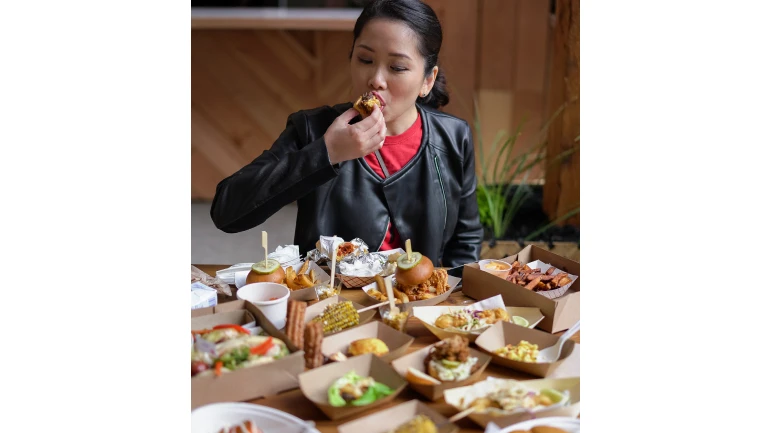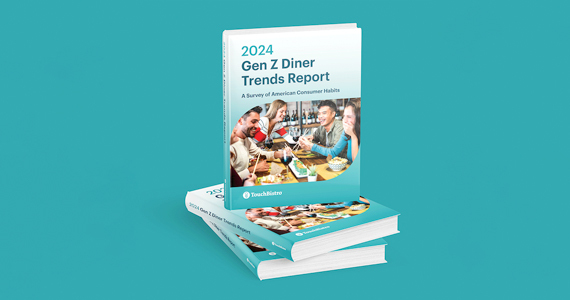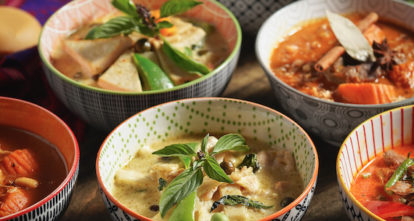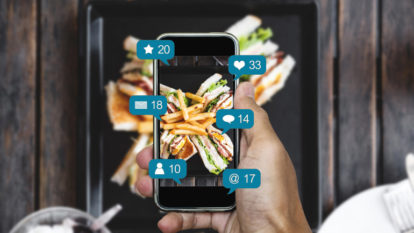Social media restaurant marketing is a great way for restaurateurs to drive traffic to their businesses. It spreads the word about your restaurant in a fun and interactive way while exposing your brand to new audiences.
However, the world of social media is not so straightforward. With changing algorithms and so many different kinds of media and channels, it’s important to prioritize content based on where your audience is and what kind of content they will respond to.
There are so many different questions to be answered about social media restaurant marketing, like what do you need to know about how to make good restaurant social media content? How do you keep up with videos and other visual media? What content creators should you collaborate with? And lastly, how do you build a genuine partnership with creators?
To answer all these questions and more, we interviewed Natalie and Tony, Content Creators at My Food Nation. Read on to:
- Meet Natalie and Tony: content creators and food lovers
- Learn simple steps to start restaurant social media marketing
- Find 10 social media restaurant marketing tips
- Uncover the do’s and don’ts of restaurant content marketing
Meet Natalie and Tony: Content Creators and Food Lovers
Tony and Natalie (“Nat”) are a husband and wife team who started posting on social media seven years ago under the name ‘‘My Food Nation’ on Facebook, Instagram, and Twitter. Over the years, their business has evolved from restaurant food photography and styling to partnerships with major restaurant and food brands. Here’s how it all unfolded.

How Natalie and Tony Started in Social Media
Tony and Natalie have been big foodies for quite a long time.
Tony posted food on his personal account for many years until it got to a point where his friends and family were telling him he should create a separate account. They didn’t want to miss the pictures of his family life and kids amongst all the food content!
“So I finally opened one for him,” Natalie recalls. “And he offered to help take proper pictures. Tony’s been a freelance photographer for quite some time, starting with portrait photography and restaurant food photography for several local brands… and that’s how he got involved and how we got started.”
More Than Just a Passion for Food
With consistent social media posting and the passion to document their food journey, My Food Nation started to gain more eyes from fellow food lovers and restaurant owners alike.
“We started getting invitations from the owners of restaurant brands to collaborate and we’ve met some incredible people,” Natalie explains.
“We continue to do it because we love it and it’s a passion of ours. Food styling is also one of our strengths, so we use those skills with the restaurant brands that we work with.”

How to Start Social Media Restaurant Partnerships
With years of experience under their belt and connections across the restaurant industry, Tony and Natalie have accumulated a wealth of knowledge about restaurant social media marketing. Below, they share their top tips for getting started.
1. Choose the Right Platforms
The number one tip for getting started with restaurant social media partnerships? Choosing the right platforms based on what demographic you want to reach.
“Between the ages of 25 and 40, Instagram is definitely the way to go, but if you are targeting Gen Z (born 1997-2012) it would likely be TikTok,” Natalie says. “YouTube is definitely good for a wider and broader audience, while Facebook is more for an older demographic.”
However, Natalie and Tony also agree that, in an ideal world, restaurant owners should have a presence on all of these social platforms, especially with the changing restaurant content marketing landscape.

Explore the latest dining trends for Gen Z consumers based on their eating habits, behaviors, and preferences.
2. Define Your Food Category and Aesthetics
Tip number two: Understand your food category and brand aesthetic before researching and choosing which content creators fit with your brand.
“From a restaurant’s perspective, you’ll want to look at the creator’s feed,” Natalie suggests. “If you’re a business that focuses on healthy eating and salads, you probably won’t want to look towards those accounts that focus on really greasy foods.” Likewise, “If you have a modern aesthetic, you may want to keep away from accounts that focus on more traditional styles.”
3. Build a Local Audience
After choosing your platforms and evaluating your brand, it’s time to start building an audience.
To build a local audience, it’s important to ask potential content collaborators about their analytics before you start to work with them.
“Everyone gets caught up in terms of numbers and stats can be skewed,” Tony warns. “So what you want to do when you’re looking for a content creator is to focus on the engagement and consistency. In addition, you’ll want to gather information about their followers including demographics and location.”
“For example, if an account has only 3% of local followers, that defeats the purpose because you’re trying to reach people who are local,” says Tony. “Anyone who sees it in Europe is not going to go into your restaurant because they don’t live anywhere near your business.”
4. Build Healthy Content Creator Partnerships
Perhaps the biggest tip for cultivating strong social media partnerships is remembering that working with content creators is a two-way street.
“We always say it’s a partnership,” Tony explains. “A business owner of a restaurant brand pays either money, food, or product to the content creator, but at the same time, you know they expect more than just a quick snapshot.”
That’s why it’s so important to build a healthy relationship between restaurateurs and content creators. Creating content takes time, work, and patience, especially with the high level of editing involved. “That’s how we work and why we’ve developed really good relationships with a lot of brands and restaurants. Mutual respect is an unwritten rule,” Tony adds.
10 Social Media Restaurant Marketing Tips
So, you’ve chosen your channels and started posting on social media. What’s next? Keeping up with best practices to gain the most exposure for your brand. Here, Natalie and Tony share 10 social media restaurant marketing tips to help you level up your content marketing efforts!
1. Start Creating Videos (And Photos)
According to Natalie and Tony, videos help you capture your viewers’ attention quickly, and they are a must-have for any business that wants to keep up with social media’s constantly changing algorithms. But not to worry, creating video content doesn’t need to be difficult for restaurateurs.
For example, Tony explains, “If you are strictly doing photos, there are now ways you can actually create a video out of it – simply stitch them together through a software app such as CapCut.”
2. Don’t Underestimate Your Phone
Think you need professional photography or video equipment? Think again. “Phones these days are unbelievable. I’ve been doing a lot of the videos on my phone,” comments Tony.
Tony also recommends buying a gimbal, a device that helps keep your phone steady and stabilized to help your camera get better results when taking videos. “Your video clips are much more smooth and sturdy, and then you can start learning how to do video transitions.”
3. Show Your Audience Behind the Scenes
Just like a lot of restaurants today have open kitchens, consumers at home also want to see what goes into the final product.
“If you can showcase how things are made and what goes into your product, this will drive a lot of interest,” Natalie comments.“When we post, I find the audience really enjoys a lot of behind-the-scenes content, like how the food is made and the work that goes into it. They also want to see how hygienic it is because cleanliness is a top priority for many consumers,” Natalie explains.
4. Consider the End Goal of Your Content
According to Tony, one of the most important things about creating content is that “you have to sit down and ask yourself what is the end goal of the content itself.”
You have to tell the story: why are you here and why should someone go to your restaurant? Maybe it’s because the recipe has been passed down from generation to generation, or perhaps your ingredients are sourced from a specific high-profile distributor – that’s what you want to showcase.
If you are working with a content creator, both parties should be sitting down and planning out your end goals, and discussing them at length to ensure you’re delivering the right message.

Explore the latest dining trends for Gen Z consumers based on their eating habits, behaviors, and preferences.
5. Highlight What Makes Your Restaurant Special
What makes your restaurant special? What’s your signature menu item? These are the types of questions Natalie and Tony always ask restaurant owners or waitstaff so they can capture and share the unique characteristics of each restaurant they visit.
“If you’re the first one to be doing something, you definitely want to highlight that fact,” Natalie reminds restaurant owners. “For example, we recently dined at the first all-you-can-eat Japanese hot pot restaurant in Toronto.”
“Think of new ways to capture that content – it could be as simple as trying out a different angle. There are always different ways to capture content where it’s out of the norm and that’s what peaks everyone’s attention,” Tony says.
6. Be Relatable to Your Audience
Creating relatable content can also help capture your audience’s attention.
Natalie and Tony often suggest that restaurant owners reveal a little bit about themselves to their customers and followers. Building a relationship, even online, can make a positive impact on a business. And while it may seem scary at first to reveal personal information, the beauty of social media is that you can control what others see, and get as personal as you want.
“You want your followers to feel welcome and approach your social platform in the same way they would if they were to be invited into someone’s home,” Natalie explains. “Giving them a glimpse of who you and your team are will get your followers to know your brand on a human level that they can relate to.”
For example, Tony adds, “One of our good friends is a local chef and he often posts about his experiments in the kitchen, both the ones that work out and the ones that don’t. He also lets his audience see glimpses of his life at home, with his kids, and how he spends his days off. These sneak peeks allow his followers to feel more connected to him and his food.”
7. Make Your Social Media Posts Interactive
Another method to capture your followers’ attention? Consider making your posts interactive by asking questions.
“We ask a lot of questions to our audience, like ‘what do you want to try?’” Natalie says. “Have you seen the ketchup and mustard ice cream?” That’s an example where we asked our audience ‘would you try this?’ So many people voted and most said no, but there were a few that said yes, I’d be willing to give it a try.”
“I think even just putting the question out there to your audience on the platform is a good way to get some data on what customers would really like and use that to develop a menu or products. Best of all, it’s free.” Natalie says. “Data collecting isn’t something you have to go out and search for. It’s just asking the question on your platform and people want their opinions heard, so a lot of people will vote that way,” she adds.
Other examples of questions Natalie mentioned include ‘What would you eat?’, ‘Would you prefer this fried or steamed?’, or ‘Would you prefer chicken or steak?’

Explore the latest dining trends for Gen Z consumers based on their eating habits, behaviors, and preferences.
8. Use Analytics to Create a Better Strategy
Of course, it’s not all about the content. Analytics is also a powerful tool and you can use social media to collect information about your audience, their tastes, and their interests.
In order to view your insights, Natalie and Tony recommend making sure your Instagram page is set to a business account. The insights link will take you to a wealth of information you can use to help your business, such as what type of posts gets the most interest and attention, the demographic and location breakdown of your followers, and when your followers are most active on the platform.
Data about when your followers are most active can be used to your advantage by allowing you to align your posting times with the day and the hours when your followers are more likely to be online. In turn, this gives your post a better chance of being seen by more people.
9. Run a Social Media Contest
One of Natalie and Tony’s biggest tips is to run a social media contest to get more exposure.
“For the contests that we run, generally the biggest rule to enter is to tag a friend, and that’s an effective way to get the word out to friends and their friends,” Natalie recommends. She explains, “Your restaurant will gain exposure not only among those who enter the contest, but also when someone else sees the post and thinks wow, this is a new restaurant I’m going to try because it looks great, even if I don’t win.”
“The purpose of a contest is to entice people to spread the word, especially if you have a brand new product or a new restaurant. You could give away three products to five different winners, for example.” Natalie explains.
A social media contest is a very cost-effective form of marketing. Think about it” if you’re giving away, let’s say $50 or $100 of food credit, it’s a lot more cost-effective than printing out 10,000 fliers and dropping them off at homes and crossing your fingers that not everyone will throw it out,” Tony adds.
Do a Promotional Giveaway
A promotional giveaway is another technique Natalie and Tony suggest that you can use to increase engagement on your social media platforms.
For example, a restaurant may offer promotional discounts or limited-time offers to drive traffic to their business. This is especially effective for grand openings or seasonal promotions. Another option is to run a loyalty program promotion to get more people to sign up for your rewards program.
10. There’s No Formula to Going Viral (But Keep Trying)
Going viral is every restaurant owner’s dream. Unfortunately, it’s not as simple as following a specific formula.
Very early on, Natalie and Tony had a viral video when they first started their account. They went to Kensington Market in Toronto, Canada, and took a blurry amateur video of a person carving a flower out of a mango.
“It was crazy how many views we had back in 2016. I think it was 110,000 views overnight,” Natalie remembers. “I guess it was new to Toronto and people were interested, and we got a lot of comments asking ‘where is this?’ and ‘where can I find this?’ While I’d love to say this is what it takes to go viral, it’s tough to tell.” Natalie comments.
“Everyone’s trying to figure out how to make a video go viral,” says Tony. “But the algorithm changes in a split second and from a business standpoint, what we recommend is to just look at your stats and see when the highest traffic is by the hour. Then, try to post at that time when your followers are online. But even then it’s so unpredictable.”

Explore the latest dining trends for Gen Z consumers based on their eating habits, behaviors, and preferences.
Do’s and Don’ts of Restaurant Content Marketing
In addition to becoming familiar with best practices, it also takes practice to avoid some common social media mistakes. In the world of social media, there are many nuances that must be learned to help your brand make a positive and professional impression on your audience. The following do’s and don’ts sum up Natalie and Tony’s tips on social media etiquette:
Do’s
- Be particular about who you work with because it’s your reputation on the line. You don’t want to collaborate with content creators whose ethics and morals don’t align with yours.
- Show respect when building partnerships with content creators. Think about what they can do for you, but also what you can do that will benefit them.
- Have patience with the social media restaurant content creation process. Editing photos and videos take time. Remember that capturing content is just half of the process.
Don’ts
- Don’t work with content creators if they tell you that they can ‘guarantee’ results. For example, they might say that they can promise to get you X amount of followers, a certain number of customers, or a specific amount of exposure. “Guaranteed” is not a word in the world of social media partnerships and marketing itself. Of course, there are potential KPIs based on conditions and probabilities of success, but unfortunately, true organic results are never guaranteed.
- Don’t focus only on numbers on a content creator’s account. As mentioned before, the number of followers and the number of comments can easily be manipulated through various tactics.
- Don’t feel like you have to agree to every influencer’s request for collaboration. You are in control of your brand and your business, and you should not be pressured to agree to any or all requests for partnerships that come your way.
Social media restaurant partnerships are about building healthy relationships with existing and new audiences by increasing exposure for your brand. Your posts can share tidbits of information about new products, menu items, and concepts and they can also help your brand collect feedback on how to improve your business. In addition, contests, giveaways, and fun behind-the-scenes content can entice viewers to share your posts with family and friends. While there is no secret to going viral on social media, it’s important to keep trying new things. At the end of the day, you just need to be relatable, mindful, experiment, and have fun! Content is king!
Free social media templates for your restaurant
Sign up for our free weekly TouchBistro Newsletter







